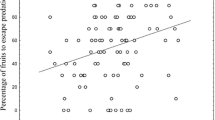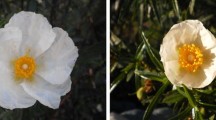Abstract
Negative frequency-dependent selection derived from positive frequency-dependent foraging is the best-known selection force maintaining genetic polymorphism within a population. However, in flowering plants, positive frequency-dependent foraging by pollinators is expected to accelerate the loss of low-frequency morphs by conferring a fitness advantage to the common morph, leading to monomorphism. In Japan, a non-native species, Sisyrinchium sp., exhibits conspicuous flower color polymorphism within a population comprising both purple morphs (homozygous recessive) and white morphs (heterozygous or homozygous dominant). Here we quantified genotype-specific reproductive success in order to reveal the contribution of overdominant selection on the maintenance of flower color polymorphism in this species. In artificial pollination experiments using individuals with identified genotypes, female reproductive success was higher in the heterozygote than in either homozygote. The frequency of purple morphs in natural populations (ca. 31 %) is similar to the frequency predicted by overdominant selection (25 %). Our results suggest that overdominant selection contributes to the maintenance of color morphs in the natural population of this species.



Similar content being viewed by others
References
Ashman T-L, Majetic CJ (2006) Genetic constraints on floral evolution: a review and evaluation of patterns. Heredity 96:343–352. doi:10.1038/sj.hdy.6800815
Chauveau O, Eggers L, Raquin C et al (2011) Evolution of oil-producing trichomes in Sisyrinchium (Iridaceae): insights from the first comprehensive phylogenetic analysis of the genus. Ann Bot 107:1287–1312. doi:10.1093/aob/mcr080
Coe EH, Neuffer MG, Hoisington DA (1988) The genetics of corn. In: Sprague GF, Dudley JW (eds) Corn and corn improvement. American Society of Agronomy, Crop Science Society of America, Soil Science Society of America, Madison, pp 81–258
Dempster ER (1955) Maintenance of genetic heterogeneity. Cold Spring Harb Symp Quant Biol 20:25–32
Dormont L, Delle-Vedove R, Bessière JM et al (2010) Rare white-flowered morphs increase the reproductive success of common purple morphs in a food-deceptive orchid. New Phytol 185:300–310. doi:10.1111/j.1469-8137.2009.03052.x
Eckhart VM, Rushing NS, Hart GM, Hansen JD (2006) Frequency-dependent pollinator foraging in polymorphic Clarkia xantiana ssp. xantiana populations: implications for flower colour evolution and pollinator interactions. Oikos 112:412–421
Ford EB (1945) Polymorphism. Biol Rev 52:691–695. doi:10.1111/j.1469-185X.1945.tb00315.x
Gigord L, Macnair M, Smithson A (2001) Negative frequency-dependent selection maintains a dramatic flower color polymorphism in the rewardless orchid Dactylorhiza sambucina (L.) Soò. Proc Natl Acad Sci USA 98:6253–6255
Hellens RP, Moreau C, Lin-Wang K et al (2010) Identification of Mendel’s white flower character. PLoS One 5:e13230. doi:10.1371/journal.pone.0013230
Majetic CJ, Raguso RA, Ashman T-L (2008) The impact of biochemistry vs. population membership on floral scent profiles in colour polymorphic Hesperis matronalis. Ann Bot 102:911–922. doi:10.1093/aob/mcn181
Makino T (1956) An illustrated flora of Japan, with the cultivated and naturalised plants. Hokuryukan, Tokyo
Maynard-Smith J (1982) Evolution and the theory of games. Cambridge University Press, Cambridge
Mojonnier LE, Rausher MD (1997) Selection on a floral color polymorphism in the common morning glory (Ipomoea purpurea): the effects of overdominance in seed size. Evolution 51:608–613
Norton NA, Fernando MTR, Herlihy CR, Busch JW (2015) Reproductive character displacement shapes a spatially structured petal color polymorphism in Leavenworthia stylosa. Evolution. doi:10.1111/evo.12659
Parra-Tabla V, Vargas CF, Eguiarte LE (1998) Is Echeveria gibbiflora (Crassulaceae) fecundity limited by pollen availability? An experimental study. Funct Ecol 12:591–595. doi:10.1046/j.1365-2435.1998.00229.x
Paulsen S, Rausher M (2000) Floral-color polymorphism in Ipomoea purpurea: biased inheritance of the dark allele is not a general explanation for its maintenance. J Hered 91:491–494
Rausher MD, Fry JD (1993) Effects of a locus affecting floral pigmentation in Ipomoea purpurea on female fitness components. Genetics 134:1237–1247
R Core Team (2014) R: a language and environment for statistical computing. R Foundation for Statistical Computing, Vienna, Austria. http://www.R-project.org/
Salzmann CC, Schiestl FP (2007) Odour and colour polymorphism in the food-deceptive orchid Dactylorhiza romana. Plant Syst Evol 267:37–45. doi:10.1007/s00606-007-0560-z
Schemske DW, Bierzychudek P (2007) Spatial differentiation for flower color in the desert annual Linanthus parryae: was Wright right? Evolution 61:2528–2543. doi:10.1111/j.1558-5646.2007.00219.x
Silva DP, Moisan-De-Serres J, Souza DC et al (2013) Efficiency in pollen foraging by honey bees: time, motion, and pollen depletion on flowers of Sisyrinchium palmifolium. J Pollinat Ecol 11:27–32
Sinervo B, Lively C (1996) The rock-paper-scissors game and the evolution of alternative male strategies. Nature 380:240–243
Smithson A, MacNair MR (1997) Negative frequency-dependent selection by pollinators on artificial flowers without rewards. Evolution 51:715–723
Stephenson AG (1981) Flower and fruit abortion: proximate causes and ultimate functions. Annu Rev Ecol Syst 12:253–279. doi:10.2307/2097112
Streisfeld MA, Kohn JR (2005) Contrasting patterns of floral and molecular variation across a cline in Mimulus aurantiacus. Evolution 59:2548–2559
Tacuatia LO, Souza-Chies TT, Flores AM et al (2012) Cytogenetic and molecular characterization of morphologically variable Sisyrinchium micranthum (Iridaceae) in southern Brazil. Bot J Linn Soc 169:350–364
Tacuatiá LO, Eggers L, Kaltchuk-Santos E, Souza-Chies TT (2012) Population genetic structure of Sisyrinchium micranthum Cav. (Iridaceae) in Itapuã State Park, Southern Brazil. Genet Mol Biol 35:99–105
Takahashi Y, Yoshimura J, Morita S, Watanabe M (2010) Negative frequency-dependent selection in female color polymorphism of a damselfly. Evolution 64:3620–3628. doi:10.1111/j.1558-5646.2010.01083.x
von Wettberg EJ, Stanton ML, Whittall JB (2010) How anthocyanin mutants respond to stress: the need to distinguish between stress tolerance and maximal vigour. Evol Ecol Res 12:457–476
Weiss MR (1995) Floral color change: a widespread functional convergence. Am J Bot 82:167–185. doi:10.2307/2445525
Yamaguchi H, Hirai S (1987) Natural hybridization and flower color inheritance in Sisyrinchium rosulatum Bickn. Weed Res 32:38–45
Yeaman S, Chen Y, Whitlock MC (2010) No effect of environmental heterogeneity on the maintenance of genetic variation in wing shape in Drosophila melanogaster. Evolution 64:3398–3408. doi:10.1111/j.1558-5646.2010.01075.x
Zufall RA, Rausher MD (2003) The genetic basis of a flower color polymorphism in the common morning glory (Ipomoea purpurea). J Hered 94:442–448. doi:10.1093/jhered/esg098
Acknowledgments
This study was partly supported by JSPS KAKENHI Grant No. 26650154.
Author information
Authors and Affiliations
Corresponding author
Electronic supplementary material
Below is the link to the electronic supplementary material.
Rights and permissions
About this article
Cite this article
Takahashi, Y., Takakura, Ki. & Kawata, M. Flower color polymorphism maintained by overdominant selection in Sisyrinchium sp.. J Plant Res 128, 933–939 (2015). https://doi.org/10.1007/s10265-015-0750-7
Received:
Accepted:
Published:
Issue Date:
DOI: https://doi.org/10.1007/s10265-015-0750-7




